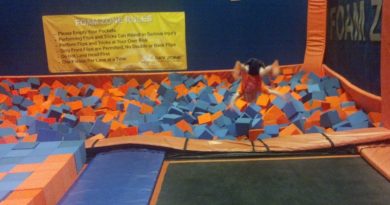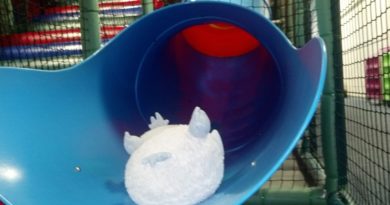How to Make or Buy a Face Mask
by Janet Jonus
We are social distancing. We are washing our hands. We are staying at home. Should we also be wearing face masks when we are out in public places?
The answer had been up in the air (no pun intended), but now the definitive answer seems to be a resounding YES!
Jospeh Allen, the director of the Healthy Buildings Program at Harvard University’s T.H. Chan School of Public Health, wrote a Washington Post op-ed arguing for Americans to wear masks.
“The debate is over. You should be wearing a mask when you go out,” Allen wrote.
Allen said wearing a mask would, “… prevent the user from infecting others by acting as a physical barrier that will block large droplets from coughs and sneezes … [It will] protect you from others around you who might be sick [and] serve as a reminder not to touch your face.”
N95 masks and surgical masks are needed by the frontline doctors and nurses in hospitals. Instead of taking one of these precious masks away from a medical person who needs it, it is best if the rest of us make our own masks.

Why do I need a mask?
New studies are showing the SARS-CoV-2 virus is being spread by infected people who do not know they have the virus. 25-50% of all infections are caused by these “silent spreaders”. These people are either have no symptoms or they have not yet started having symptoms, but they are still shedding the virus through their breath.
More studies are showing the virus can be aerosolized. The virus is present in droplets that are expelled by coughing, sneezing, talking, and even breathing. Droplets are heavy. They quickly fall to what ever surface is beneath them (which is why you have to disinfect all surfaces and wash your hands). New studies are showing the virus can also be expelled as small particles, called “aerosol”. These particles can remain suspended in the air for hours.
A mask can prevent breathing in droplets but not aerosol particles. Experts feel that anything is better than nothing, which is why they are recommending face masks for everyone.
If I wear a face mask, can I go out and stop social distancing?
NO! You still need to avoid contact with other people, wash your hands, disinfect all items and surfaces, AND maintain social distancing.
Face Masks are an ADDITIONAL step to take to not get the SARS-CoV-2 virus. They are NOT FOOLPROOF. They are NOT A SUBSTITUTE for staying at home, cleaning surfaces and hands, and social distancing.
How to properly wear a face mask.
The mask MUST COMPLETELY COVER THE NOSE AND THE MOUTH. The top of the mask should be on the bridge (the hard part) of the nose. The mask should be tight around the edges and flat on the face. If there is a metal piece on the nose of the mask, bend it so it fits snugly on your nose. Move the mask around to prevent gaps around the edges.
Clean you hands before you put the mask on. Make sure it is comfortable. Do not adjust the mask once you are out in public. You have to assume the mask has coronavirus on it once you go out in public. If you do touch the mask, wash your hands immediately. When it is time to take the mask off, carefully remove the mask, folding it inside out, and place it in the wash or in a bag to be transported to the wash. Wash your hands after taking your mask off. Wash you face after you take your mask off.
To clean you masks, wash it in the laundry with warm or hot water. Dry it on high heat. We put our masks in a lingerie bag, like the one below, to wash them.
Okay, so how do I make a Face Mask?
The first step is to use the correct material.
Choosing the material
Your face mask should contain several layers of fabric. We recommend at least four layers of fabric:
- The INNER FABRIC – This should be made from a soft wicking fabric. Wicking fabric moves moisture away. When you breath out, there will be moisture. You want your face mask to stay dry.
- The LINING FABRIC – This is the most important fabric. The best fabrics for these layers are densely-woven, cotton fabrics. Fabrics that are 100% heavy cotton, like denim, duck cloth, percale, or heavy sheets work well. To test your fabric, double it then hold it up to a bright light. If you cannot see the light through the fabric, then it is a good fabric to use. There should be 2-3 layers of the lining fabric.
- The OUTER FABRIC – This should be a water resistant fabric, like tent fabric.
- Optional DECORATIVE LAYER – Make your face mask good looking with an optional, decorative layer. Cotton is a good choice for this layer.
- ELASTIC or TIES – There are many choice for elastic to hold your mask on, depending on the design you choose. 1/4 inch elastic or regular, elastic hair bands work for ear-loop masks. 1/4-3/8 inch elastic band works for around the head masks. Alternately you can use double-fold seam binding, cotton cord, ribbon, or show laces to tie the mask on.
- Paper Clips, Needle and Thread or a Sewing Machine, Scissors – Paper Clips can be used inside of a mask to make a moldable nose bridge and to hold pieces of fabric together for sewing. (Pins can be used too but they will put tiny holes into the fabric.) Most masks need to be sewn. A needle and thread will work as will a sewing machine. You will need scissors for cutting materials and the thread.
- All FABRIC needs to be washed before using it. This cleans the fabric and shrinks it. All fabric choices should NOT be stretchy. Chose fabric with no stretch.
Super Easy No-Sew Face Mask
This super easy, no-sew face mask will can provide basic protection. If you cannot sew, this isn’t a bad option.
Cut your materials:
NOTE: To make this truly a “No-Sew project, you will need:
- One medium weight cloth napkin about 20 inches by 20 inches (Note: There is a video online that uses a bandanna for this project. Most bandannas are made from thin fabric. This fabric is far too thin to make an effective mask. If you are using a bandanna or a thin cloth napkin, use two together.)
- Two pieces of 4 inch by 7 inch piece of very thick or heavy fabric (like denim or felt. If you are using felt, you can throw it out after every use use as it does not wash very well. You can wash denim, but the edges will fray. )
- Two hair elastics or rubber bands
To make your face mask:
- Fold the piece of cloth in half. Place the piece of felt inside the fold, at the center of the piece of fabric.
- Fold the fabric in half again. You should have a long folded piece of fabric with your felt piece inside.
- Place an elastic band around the folded fabric, approximately six inches from the edge.
- Place the second elastic band around the folded fabric, approximately six inches from the other edge.
- Move the metal part of the elastic bands so they ares facing up (so you can see them).
- Fold the outer edges into the center of the fabric at the elastic bands.
- Tuck one edge of the folded edge into the other side.
- Place the mask on your face, looping the elastic bands around your ears and making sure the mask covers your nose, mouth, and chin. Move the fabric so it lies flat on your face, closing any gaps. Adjust the elastic bands if necessary.
- NOTE: This is a basic mask. It will not have the snuggest fit, but it is better than nothing.
To care for this mask: All of the components of the mask can be washed. It will come apart in the wash. Discard the felt after it has been washed (the weave will be too loose to reuse.) Reassemble the mask with a new piece of felt the next time you use it.
Mask- Making Supplies
Here are some options for masks. These napkins are great for any kind of mask – either the easy mask above or as fabric for a hand-sewn mask. They are made of cotton and come in a rainbow of colors.
These felt squares can be used as a filter in face masks. They come in a package of 44, which will work well since felt can not be washed and retain their weave.
These hairbands can be used for the simple fast face mask. They hook over the ears.
Can I Buy a Face Mask?
Yes, of course. There are numerous crafters and companies who now make cloth face masks. Cloth face masks can be reused as long as you wash them in between uses. They come in many shapes, sizes, and looks. There are also surgical quality, disposable face masks available. Disposable face masks are meant to be used once and then thrown away.
There are two ways to keep a mask on – ear loops and ties. Most disposable masks come with loops. The pros are they are easy to put on and take off, the cons are ear loop masks usually do not fit well. Most people seem to be using this kind of mask, and they struggle to keep the mask on while they move around and talk. We prefer face masks with ties. All of our face masks have ties. They can be fit perfectly and they stay in place. Tie face masks are harder to find.
Disposable Face Masks
Cloth Face Masks
These face masks are made from a bamboo and spandex blend. Bamboo has as a higher filtration rate. The spandex allows for some stretch. The masks have a metal nose strip and are adjustable. They come in adult and children’s sizes. Reviewers say they are comfortable to wear.
The BEST thing to have for your ear loop face mask! SNUGLY Extending Bands
Are you having fit problems with your era loop face mask? Do the loops hurt your ears? Are you finding it difficult to get a good fit for your kids? Try this silicone band. Just loop the ear loops on your face mask onto the band and put it on. The loops are held by the band, creating a good, comfortable fit.




